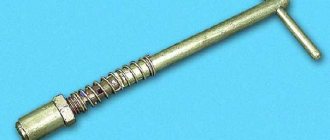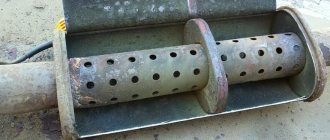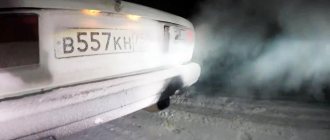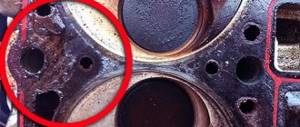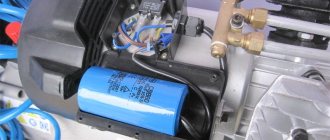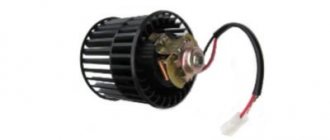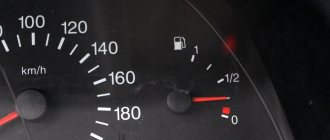Probably all car owners have seen white smoke coming from the exhaust pipe. This is quite a popular phenomenon, especially in winter. This often frightens beginners - they feel like the machine is broken. This phenomenon can be seen at the moment when the engine has just been started and it begins to warm up. In such a situation, white smoke is completely acceptable. It informs the owner that a lot of moisture has accumulated in the exhaust system. We can say that it is not even smoke, but rather steam. Therefore, it is important to warm up the car thoroughly until all the moisture has completely evaporated. The presence of moisture can be determined by drops of water. They will accumulate on the edges of the muffler pipe. After all systems, and in particular the exhaust, are completely warmed up, the steam will completely disappear. Let's take a closer look at where the white smoke comes from the exhaust pipe, let's look at the reasons for this phenomenon, because the issue here may not only be due to high humidity.
When is it a problem
In winter, when the engine warms up, steam from the car exhaust pipe is the norm. However, if it comes from the pipe in the summer, and even when the engine is warm, this is already a cause for concern.
Perhaps the cylinders are to blame. Moisture can get into them and therefore steam will form. Another option is a broken cylinder head. Here we need to take a deeper look at the technical part. Cylinder head destruction sometimes occurs due to water contained in the coolant. When the fuel burns, the water simply does not have time to completely evaporate. That's why white smoke comes out of the exhaust pipe. It should be noted that the color and shade of the steam may not be completely white. It depends on many factors, including the type of coolant, air temperature and humidity level. It happened that in poor lighting, white smoke from the exhaust pipe during startup was confused with smoke from burning oil. But here it is easy to draw conclusions based on the residual indicators. Oil vapors have one interesting property - they hang in the air. And the steam instantly evaporates. You can distinguish the types of smoke based on these characteristics.
What is exhaust?
If the car engine and all other equipment are in good working order and functioning in their normal mode, then the exhaust is a compound of steam. The gases also contain nitrogen and carbon dioxide. These substances are almost completely discolored.
An invisible stream flows from the pipe. A catalyst takes part in the cleaning, in which harmful substances are neutralized. Let's take a closer look at white smoke from the exhaust pipe, the causes of this phenomenon and ways to solve this problem.
Evaporation of condensate
If the driver suddenly notices that during the warm-up process or when accelerating at low speed, white exhaust is coming out of the pipe, then, as mentioned above, there is no need to panic. This is a common and harmless occurrence. The reason is that after the last trip, a lot of condensation formed in the combustion chambers, as well as in the resonator and muffler due to cooling. When the motor is started, the water defrosts and boils. As a result, “cold” white smoke comes out of the exhaust pipe. Then, after some time, all the condensate boils away and the steam no longer flows.
Antifreeze in the exhaust manifold
If it’s warm outside, and white smoke comes out of the chimney and doesn’t go away after warming up, this indicates problems in the engine.
Coolant enters the combustion chambers. Antifreeze evaporates when the fuel burns, and thick white smoke forms at the outlet of the muffler. But the color, as already noted, may depend on the type of antifreeze.
Diagnostics: water or antifreeze?
To be completely sure that it is steam coming from the pipe and not evaporating antifreeze, you can conduct a small experiment. A piece of thick paper is brought close to the exhaust with the engine running. There should be no greasy stains left on it. If so, then it is water vapor. If stains remain, then it is coolant. Then additional steps are taken to make a more accurate diagnosis.
Unscrew the expansion tank cap, then start the engine. Now you need to detect oil stains on the surface of the coolant. It is recommended to check the smell of antifreeze - it may smell like exhaust gases. If a characteristic oil film is visible on the surface of the coolant and the antifreeze smells of exhaust gases, this indicates a broken gasket under the cylinder head. It is also possible that there is a crack in the cylinder itself. If this is the case, the coolant level in the tank will increase. The pressure will increase due to exhaust gases entering the cooling system. As a result, white smoke comes out of the exhaust pipe, but “hot”. After each trip on such an engine, you can see how quickly the coolant decreases. Leakage of antifreeze and its subsequent entry into the cooling system or into the sump leads to mixing of antifreeze and oil. You can diagnose it by the color of the lubricant. It will have a milky color on the dipstick. This oil is no longer suitable for use. It has completely lost its lubricating properties.
White smoke from muffler | Twokarburators.ru
Let's consider the reasons for the appearance of white smoke from the muffler (exhaust pipe) on VAZ 2108, 2109, 21099, 2105, 2107 passenger cars. Why black and blue smoke occurs is discussed in separate articles on our website.
Reasons for the appearance of white smoke from the muffler
1. Low temperature outside.
As it warms up, the smoke either disappears completely or is insignificant. In this case, the white smoke is condensate accumulated in the exhaust tract. This phenomenon is not a malfunction.
2. The cooling system is faulty.
Coolant enters the combustion chambers, or directly into the lubrication system, through cracks in the block, engine head, or a burnt gasket between the head and the block. External signs of this malfunction, in addition to white smoke from the exhaust pipe, are: - a constant drop in the coolant level in the expansion tank
— unstable idle speed
— bubbling of gases in the expansion tank on a warm engine
— an oil film on the surface of the coolant in the expansion tank
- a spark plug in a “broken” cylinder will be cleaner
- foamy, bluish coating on the oil filler plug
- constant engine overheating
— after stopping the engine, there is an emulsified white coating on the dipstick on top of the oil.
The malfunction can be eliminated only by repairing the engine, with the replacement of failed parts.
Notes and additions
— Everyone knows the test with a sheet of paper. A white sheet of paper must be brought to the outlet of the muffler on a warm, running engine. And hold it like that for a while. The presence of watery-oil stains on the sheet indicates a leak in the cooling system.
Five more articles on the site on VAZ car engines
— Primary diagnostics of malfunctions of carburetor engines
- Shoots at the silencer
— Increased oil consumption by carburetor engine
— “Troyt” engine
— Measurement of compression in the cylinders of a carburetor engine
twokarburators.ru
Other reasons
If white smoke comes from the exhaust pipe, the cause may be a burnt gasket. However, the problem is not only in the gasket itself, but also in the head, or rather, in its plane. This defect often occurs when the engine overheats. However, at the stage when the violation of the cylinder head plane is not yet so pronounced, it is not noticed. In this case, you should observe the combustion chamber - there is a possibility of detecting a crack.
It can be identified by checking the tightness. This check is simple to perform. The piston is lowered to bottom dead center and it is found out whether there is liquid inside. It can be found quite rarely, but attentiveness in this matter will not be superfluous. Often white smoke from the exhaust pipe (including VAZ-2170) can be observed when a low-quality intake manifold gasket was used during maintenance. In this case, moisture enters the combustion chambers through the intake system. This option is the worst, since it is very difficult to diagnose the problem. The cooling system always has normal pressure and there are no exhaust smells. But an emulsion still forms in the oil pan, and the coolant level drops. The dipstick should be checked every two weeks. This will protect you from premature breakdown and problems with the power unit.
White smoke from the exhaust pipe
What it looks like: thick white steam when the engine is hot.
White-gray water vapor in cold air after an overnight stay is a completely normal phenomenon, indicating sufficient humidity in the exhaust system. It dissipates easily and quickly, and disappears completely when the engine heats up. It’s another matter if the exhaust literally “hangs” in the air, turning into a thick cloud, and remains even after complete warming up.
Reason: coolant has entered the engine cylinders: most likely, the cylinder head gasket is damaged or a microcrack has formed in the cylinder head or block.
Hint: noticeable antifreeze leak.
Actions: check the coolant level and contact service - gases entering the cooling system can result in engine overheating and subsequent major repairs.
Important: before you begin, make sure that it is water vapor coming from the pipe, and not smoke mixed with oil. To do this, bring a sheet of paper to the pipe and wait a little: the moisture will evaporate without a trace, and the smoke will leave oil stains.
What about diesels?
Injection of the fuel mixture in a diesel engine means supplying it to the combustion chambers under high pressure through injectors. When the mixture passes through the nozzle, a torch is formed, due to which the mixture in the cylinder is divided into small droplets.
These particles are then heated inside the chamber and actively evaporate. A fully operational engine in any operating mode receives an effective atomized portion of the mixture strictly at the right moment in the compression stroke. The mixture then spontaneously ignites when heated. Next, the combination of diesel fuel and air burns, releasing energy. White smoke comes from the exhaust pipe of a diesel engine, despite the difference with a gasoline engine, due to the same reasons - increased moisture content in the exhaust system, incomplete combustion of the fuel mixture, coolant in the combustion chambers. And if everything is clear about condensate, then about the incompletely burning mixture needs to be explained in more detail.
Shades of exhaust from cars with carburetor engines
Exhaust smoke from car models with carburetor engines can also have a white, black or bluish tint. They indicate the following malfunctions:
White smoke
White exhaust indicates that water has entered the Niva’s fuel mixture. This can occur as a result of condensation forming in the gas tank or fuel supply pipes, increased humidity during refueling of the vehicle, or water penetration from a damaged engine cooling system.
In addition, white exhaust occurs due to a violation of the tightness of the gaskets, refrigerant entering the engine cylinders, or water leakage in the heating system. In certain situations, white smoke is produced due to insufficient engine warm-up. When its temperature does not reach the required values, a certain amount of water remains in the exhaust system. For this reason, it is not advisable to make short trips in frosty weather.
Exhaust smoke has a bluish hue
Such exhaust can be formed due to oil entering the combustion chamber. This usually occurs due to significant wear of the cylinders and piston system. The degree of wear of the parts of these mechanisms can be determined by measuring the compression level. If this indicator corresponds to the established standard, then the cause of the bluish smoke may be damage to the seals, bushings and valve seals of the Niva.
Possible malfunctions that can cause the formation of bluish smoke also include a reduced degree of elasticity of rings, cuffs, bushings and valve plates, worn valve seats, and an increased oil level. Such smoke also appears due to the use of low-quality fuel with oil impurities.
Also interesting: Niva Chevrolet front suspension
Black exhaust
Black exhaust has a color that is given to it by soot, which is formed due to incomplete combustion of the fuel mixture.
This happens due to the supply of fuel that exceeds the norm of enrichment to the carburetor. Black exhaust also occurs when there is more fuel in the float chamber than normal. We can also identify such malfunctions as clogged holes, wear and damage to jets, a damaged air supply system damper, a faulty idle air valve, and low-quality spark plugs.
When determining the cause of the formation of Niva exhausts of a certain color and shade, you should remember that such exhausts can be caused by more than just one malfunction. This phenomenon can be a sign of several different damages and breakdowns at once, especially in old cars with worn out parts and mechanisms. However, in general, the above reasons for emissions will allow you to choose the right direction for troubleshooting and repair the Chevrolet Niva or another car in a timely manner.
In the video we'll see how to blow out the exhaust pipe to get rid of black exhaust once and for all.
Incomplete combustion of diesel fuel
White smoke from the exhaust pipe of a diesel engine during its warming up occurs if ignition is untimely. This color indicates gases that were supposed to give energy to the piston. This phenomenon is typical even for a working motor.
In the first case, the mixture enters the combustion chambers, then evaporates, but does not burn completely, since the supply is carried out at a fixed angle. This happens due to the temperature inside the cylinders not being high enough. If a diesel engine emits white smoke, this indicates that the injectors are spraying the mixture normally. And an untimely outbreak leads to a decrease in temperature, the combustion rate and uniformity decreases. There may be problems with glow plugs, decreased compression, excessive injection pressure, and plunger pairs of the high-pressure fuel pump.
Blue smoke from the exhaust pipe
What it looks like: oil gray-blue exhaust.
Depending on the degree of lighting and weather conditions, the exhaust can change shade from light blue to deep gray. In any case, strong blue smoke from the exhaust usually indicates oil in the cylinders.
Reason: Oil can get into the engine for various reasons:
- simple engine wear, when the piston rings lose their seal and compression deteriorates, and more oil is consumed;
- “occupancy” of the rings (coking, loss of mobility) due to low quality oil and fuel or infrequent use of the car and concomitant overheating;
- disturbances in the crankcase ventilation system due to excessive pressure in the cylinders, when the engine begins to “on its own” remove exhaust gases, re-burning them;
- “aged” oil seals on the valves, which have lost their elasticity and are gradually leaking oil into the manifold and further into the combustion chamber.
Hint: Significantly increased oil consumption.
Actions: perform a complete engine diagnostics, measure compression, decarbonize if necessary, replace worn elements and oil.
We recommend KIXX oils and lubricants - impeccable quality and excellent compatibility even with the most capricious engines.

